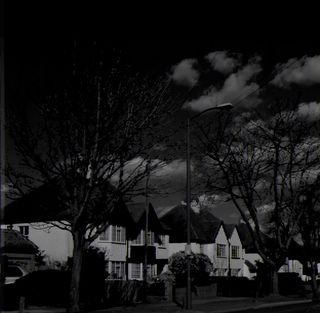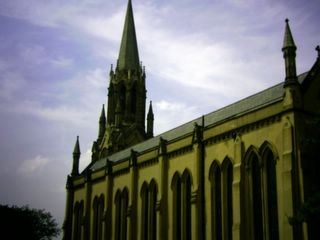
The River Bed!!

To find the place where England ends and England can begin?



 Here you enter Hall Place grounds (see previous entry on Hall Place). Walking here is very pleasant as is crossing into Churchfield Woods. Again one quickly leaves behind the noise of the traffic on Rochester Way. Out of the woods, which would be a romantic spot to take a significant other, I passed by a cemetery and up to Bexley church. This flint church was locked unfortunately. The path comes out by the old mill (turned into a public house) and passes over the Cray again. Here is an old house by the mill.
Here you enter Hall Place grounds (see previous entry on Hall Place). Walking here is very pleasant as is crossing into Churchfield Woods. Again one quickly leaves behind the noise of the traffic on Rochester Way. Out of the woods, which would be a romantic spot to take a significant other, I passed by a cemetery and up to Bexley church. This flint church was locked unfortunately. The path comes out by the old mill (turned into a public house) and passes over the Cray again. Here is an old house by the mill. 


 Bexley – a borough of many surprises. Bromley – the London Borough
Bexley – a borough of many surprises. Bromley – the London Borough
 Foots Cray meadow is a pleasant spot for walking, picnicking and taking the air and is very well used for these purposes. The walk continues by the Cray until it reaches All Saints Church Foots Cray.
Foots Cray meadow is a pleasant spot for walking, picnicking and taking the air and is very well used for these purposes. The walk continues by the Cray until it reaches All Saints Church Foots Cray. 
 This is an ancient church from 1330 although altered in the 19th Century reached from its Lych gate by an avenue of small yew trees. I was not able to see the interior but it has many historic artefacts.
This is an ancient church from 1330 although altered in the 19th Century reached from its Lych gate by an avenue of small yew trees. I was not able to see the interior but it has many historic artefacts.


 There is also an old black and white house in the high street
There is also an old black and white house in the high street 
 and a view of the coca cola™ bottling plant that was famous for taking tap water and selling it as Dasani. I walked past the crumbling grandstand (well not very grand) of Cray Wanderers Football Club and some overgrown allotments to come out onto a hill with a pitch and putt course and three giant redwoods. In California (where these trees are native) one of the trees has a tunnel cut through it and one can drive a car through it. These trees could have a tunnel cut for a bicycle or mopèd. This is Sidcup Place and there is a mansion
and a view of the coca cola™ bottling plant that was famous for taking tap water and selling it as Dasani. I walked past the crumbling grandstand (well not very grand) of Cray Wanderers Football Club and some overgrown allotments to come out onto a hill with a pitch and putt course and three giant redwoods. In California (where these trees are native) one of the trees has a tunnel cut through it and one can drive a car through it. These trees could have a tunnel cut for a bicycle or mopèd. This is Sidcup Place and there is a mansion 
 with a beautiful walled garden, full of lavender, roses and other flowering plants. I pressed on across the Sidcup Bypass via tunnels under the roundabout and entered Scadbury Park. This was where the signage almost stopped but I managed to get through the fields and woods towards the old moated manor house of Scadbury.
with a beautiful walled garden, full of lavender, roses and other flowering plants. I pressed on across the Sidcup Bypass via tunnels under the roundabout and entered Scadbury Park. This was where the signage almost stopped but I managed to get through the fields and woods towards the old moated manor house of Scadbury. 
 Very much a picturesque ruin it needs an artist to paint it. There were two wells, one on the other side of the moat so this must be the well of loneliness.
Very much a picturesque ruin it needs an artist to paint it. There were two wells, one on the other side of the moat so this must be the well of loneliness.
 After seeing this romantic spot I got rather lost in the Oak and Birch woods of Scadbury Park. Eventually I found Paul’s Cray Road and crossed into National Trust land at Pett’s Wood. I looked for and missed the William Willets sundial. Willets was a London builder and madman who wanted more work from his men (according to one story) or who wanted to play golf later in the evening (according to another). Instead of getting up earlier and doing all his work so he could go home early he had the hair brained notion of setting the clocks forward by 80 minutes in summer and back by 80 minutes in autumn. This scheme was later modified and adopted by Lloyd George during the first world war and has continued ever since.
After seeing this romantic spot I got rather lost in the Oak and Birch woods of Scadbury Park. Eventually I found Paul’s Cray Road and crossed into National Trust land at Pett’s Wood. I looked for and missed the William Willets sundial. Willets was a London builder and madman who wanted more work from his men (according to one story) or who wanted to play golf later in the evening (according to another). Instead of getting up earlier and doing all his work so he could go home early he had the hair brained notion of setting the clocks forward by 80 minutes in summer and back by 80 minutes in autumn. This scheme was later modified and adopted by Lloyd George during the first world war and has continued ever since. 
 Pett’s wood has substantial suburban houses as per the picture,
Pett’s wood has substantial suburban houses as per the picture, 
 and no doubt substantial suburban residents. The public houses were filled to bursting with football fans so I had a take away from a kebab shop where I got a moderately good kebab.
and no doubt substantial suburban residents. The public houses were filled to bursting with football fans so I had a take away from a kebab shop where I got a moderately good kebab.

 Chalybeate is iron water, with a few other minerals and is the same type of water that feeds Tonbridge Wells.
Chalybeate is iron water, with a few other minerals and is the same type of water that feeds Tonbridge Wells.












